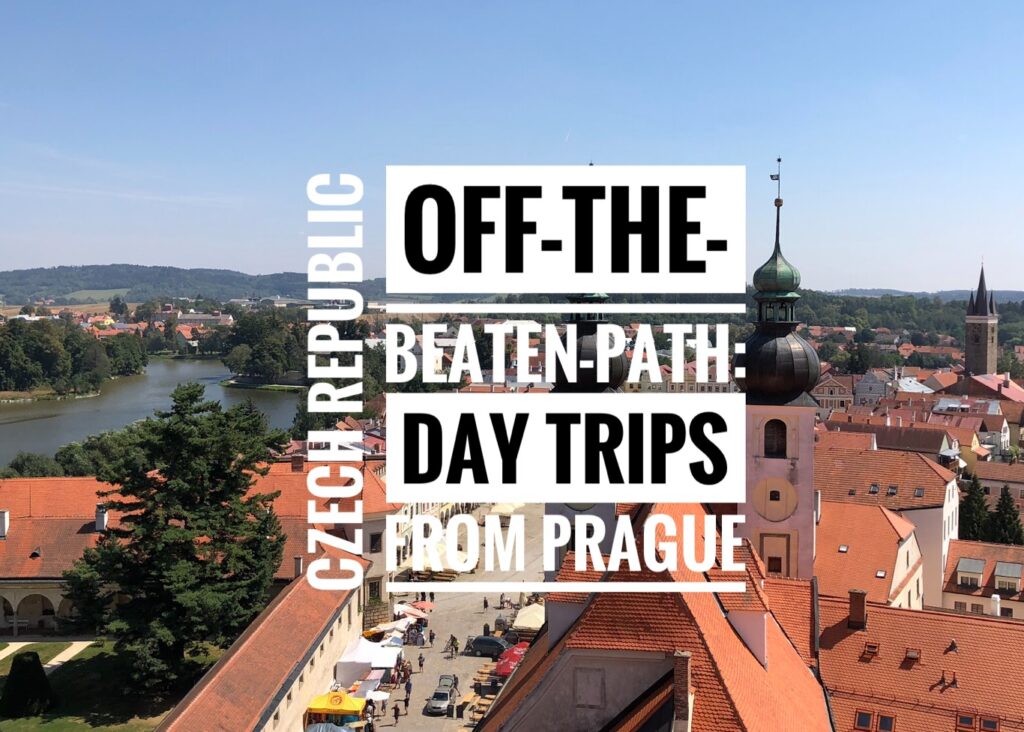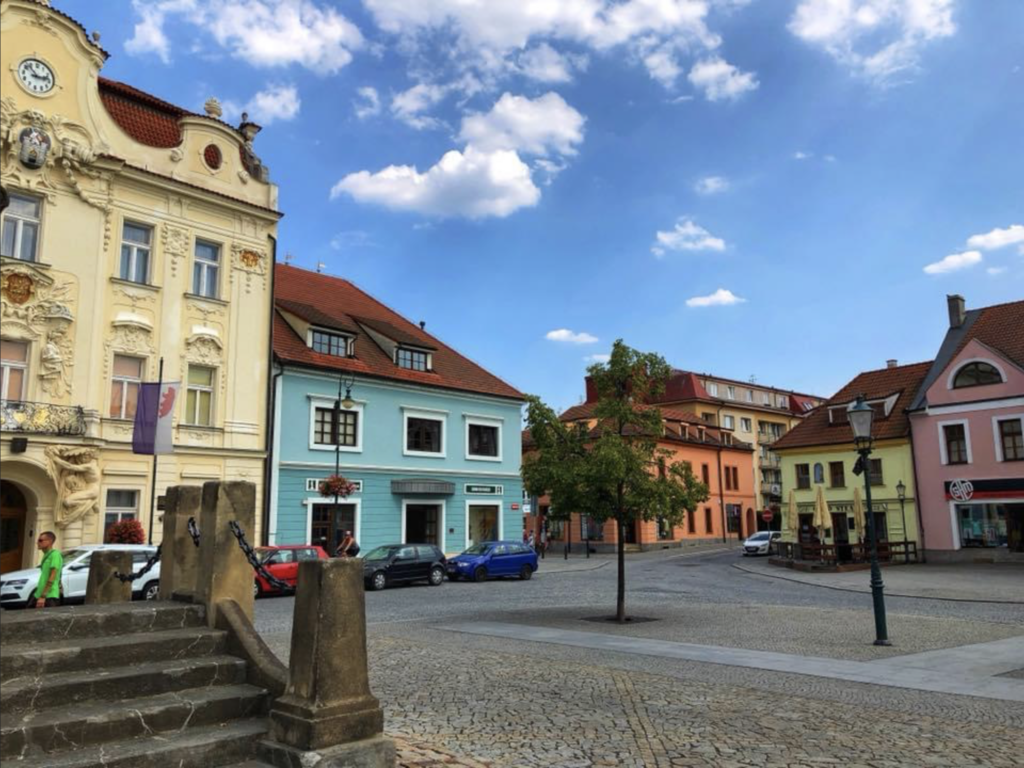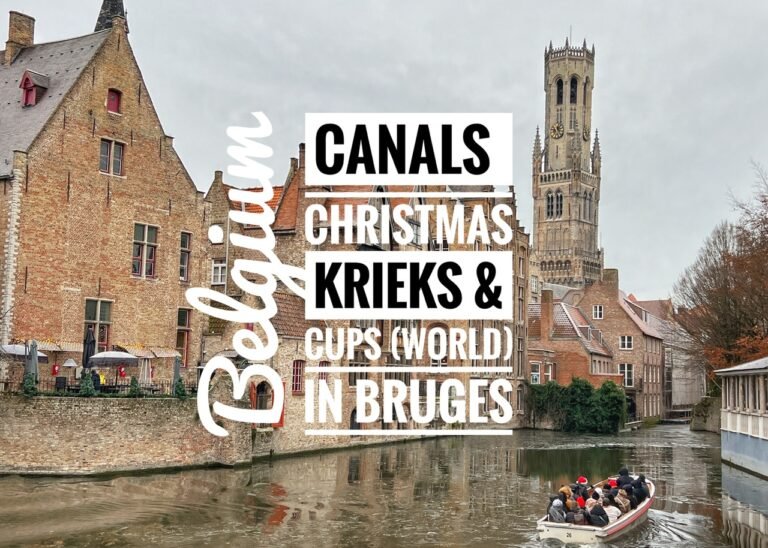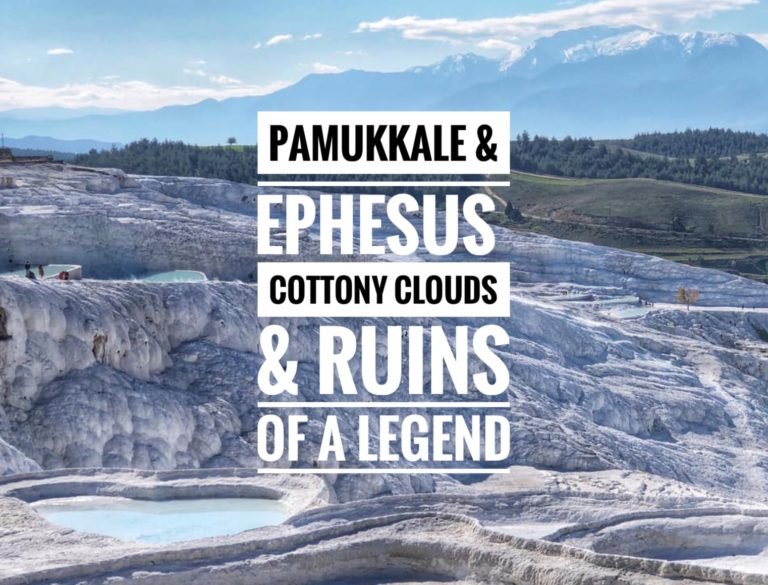
Our favorite thing to do when we lived in Prague was leave the city behind, often via the wonder paths of the Czech trail system. Trails weave through cities, villages, pastureland, valleys and hills, natural attractions, and historic sites. All with easy-to-understand color coded trail markers that even the most navigationally challenged can follow.
Geography fun fact: the Czech Republic is no longer named this; in 2016 the name was officially changed to Czechia. This name change is struggling to catch on, however, including with us. We use it interchangeably because as bloggers, we know we should use the most updated word, but as former Czech expats, we just can’t quite make our tongues want to say that.

Srbsko to Svatý Jan pod Skalou
On this journey, we hopped off the train at the small hamlet of Srbsko, only a 30-minute train from Prague, and ambled our way along creek beds and beech forests to lovely Svatý Jan pod Skalou. Starting in the little village of Srbsko, a peaceful community on the banks of the Berounka River. It’s a quick 30-minute ride from Smichovske Nadrazi in Prague. From the train station trails depart towards a number of destinations.

We hit the blue, then red trails, a 6.2k trek with the intention of cooling off under the trees in the 96 degree heatwave which swept the country tha August. Here Mandy finds nature’s A/C in “the cave” along the route.

And… disappointment at the non-waterfall waterfall. That was supposed to be here. Damn.

A traditional marker for Czech trail system. In addition to these terrific wayfinders, there are colored coded markers all along every trail. And why, oh why, can’t the States copy this brilliant countrywide system?


And our destination! Svatý Jan pod Skalou (St John under the Cliff) population 120, a real hidden treasure tucked amongst forest and rocks.

Side, note, this hike is only 6 km from the popular gothic castle Karlštejn, (which would be a great add-on to this hike). We had already been there before, however, so we opted to skip it that day.

As you may have guessed by the name, (if you speak Czech), Svatý Jan pod Skalou, is surrounded by rocks. And the view from the lookout above is well worth the calorie-burn. Look closely and you can see the cross on the top by the indicated arrow.
Pictured here is the St. John Benedict Monastery that once served as a labour camp, a prison, and a school for the secret police during the Communist regime. For that very reason, Svaty Jan pod Skalou was not identified on a map for many years. Many of its historical monuments were not maintained as a result. Interestingly the spire on top of this monastery was actually erected in 999 about 30k away on another church, but after that building came under attack during the Hussite Wars in the 15th Century, it was moved here. (Wikipedia)

Hidden Gem: From within the monastery you can enter a true marvel of this village… an ancient cave church within the church. The cave church has its root in the Middle Ages, at the end of the ninth century. At that time, the first Christian Monk Ivan came here and lived in the cave for 42 years. Legend says that Ivan had to first fight the devil, he so wanted to go away. In his sleep appeared St. John the Baptist, who gave him the Saint [Holy] Cross and told him to return back to the cave and defeat the devil with the cross. So, Ivan returned to the cave and won against the devil and later he met with the Czech Duke Borivoj who promised to build a Chapel in the name of St. John the Baptist-why it is named so. (https://www.radio.cz/en/section/spotlight/svaty-jan-pod-skalou-st-john-under-the-cliff)

At the side of the church, under the window of Ivan’s cave church, is St. Ivan’s Spring, a spring well that legend says locals used to cure disease. Water from local springs also used to be bottled up and sold as the mineral water ‘Ivanka’.

So incredible! A real cave and medieval church that is actually inside the monastery !! There is a stone bench here that is said to have been Ivan’s bed, where at one point he received a beating and thrashing upon it by a wicked local Shepard. Ivan’s Blood stains from his beating can still be viewed on the rock.

Meet Ivanka. The most delicious (free:) mineral water we could ask for on that scorching day. Be sure to push the button in order to summon the saint approved water.

After filling our water bottles, and debating if it would be worth it on such a hot day, it was time to set off 1.2k straight uphill to the peak viewpoint.

The quick, but very steep path up.

And… It’s worth it. Always worth it.

A view of the village and monastery below from the cliff. Wow! Now we’re in Bohemia…

Beroun
Next, we took a bus about 15 minutes to the town of Beroun. This proved that almost anywhere you go in CZ will be beautiful. The lovely town square was an unexpected pleasant surprise to us.

Street scene Beroun…not a single car in sight and look at the view! 🙂

Walking through the clock tower.

And here it is. The real reason we stopped in Beroun… Berounsky Medved, the brewery where we had our most-loved-beer-ever in 2008! We have reminisced about the beer here multiple times over the years. Literally a diamond in the rough… Set in an auto salvage yard amidst old military guns and transport carriers; only a block from the Beroun train station. This is our kind of discovery!

All the beers are delicious unfiltered, unpasteurized, yeasty beers. Greg is already fantasizing about cloning them someday and Mandy is fully supportive.

We finally broke down and got smazeny syr (fried cheese) the oh-so-perfect Czech complement to a delightful beer.

Greg might fall in…

Umm, he might have a few more swallows.

Fortunately, we were taking the train back to Prague.

Želízy & Čertovy hlavy
On another day, we took the train about two hours to Želízy to find some eerie discoveries in off the beaten path in Czechia. From Želízy, you take the blue trail to Čertovy hlavy (Devil’s Head), which is a pair of rock sculptures created by Václav Levý in the 1840’s. It is sometimes called the “creepiest place in the Czech Republic.”

The sculptures are about 10 meters (35 feet) high. They have been naturally weathered since their creation and will likely entirely disappear within 50 years, so don’t wait too long to check them out.

According to Wikipedia, the trail also leads to the Klácelka cave system, which contains reliefs of prominent personalities and heroes in Czech history. Not really sure if this was them or not, but we just stumbled upon these guys.

Telč
It’s pretty much impossible not to fall in love at first sight with this quintessential (UNESCO) Moravian medieval town, which we reached from Prague in 2.5 hours by bus.

Founded in the 13th Century as a royal water town, it just oozes charm and history with its Italian Renaissance architecture, chateau, and tranquil medieval carp ponds.
The town that you see today was developed in the 14th Century after a great fire. Zachariáš of Hradec, the ruler at the time, decided to change the castle from Gothic to Renaissance after a visit to Italy, and then the town quickly followed his style with their townhomes on the square. Because obviously, everybody wanted to copy Italy.

As they were doing this, the locals tried to out-do each other by flaunting their wealth with the fronts of their homes. That is why you will see such elaborate ornamental and intricate details throughout the main square. The detailed businesses and homes that line the square feel like they’re plucked right out of a storybook. What unbelievable ambience.

Other views in the square.


Climbing to the top of the watch tower for that mandatory picturesque view…Hmmm. What a strange knocker that bell has!!

From the top of the tower, you can see the carp ponds which surround the village on three sides like a large moat. Carp, unlike in most places, is seen as a bit of a “royal” fish. In fact, it is the Czech tradition to eat this often ridiculed fish for Christmas dinner, breaded and deep fried. We actually remember the holidays in Prague where carp are sold everywhere on the street freely swimming in bathtubs. Greg even got to partake in this tradition in Slovakia a couple of times. It was soaked in milk for hours to make it taste a little less “fishy.”

This sleepy town couldn’t get more walkable…

…or romantic.

It broke our hearts not to be able to stay overnight in this living fairytale, but it just so happened we were visiting during a festival and everything was booked solid.

Maybe next time…haha.

Český Ráj (Bohemian Paradise)
Flashing back to 2007-2008, we also had to include some of our other favorite day/weekend trips from Prague. Český Ráj, also known as Bohemian Paradise, is certainly a place we will never forget. In fact, this was the very first trip Greg whisked Mandy on only two weeks after we’d met. He was in hard-core wooing mode and this suitably named paradise two hours by train from Prague, made it an absolute walk in the park, particularly with its pristine white snowy backdrop.
Český Ráj is simply exquisite. This protected utopia is piled with volcanic pillars, hilltop castles, amongst teacup villages, all embedded within a layer of lush and majestic forest.

Naive-young Mandy waits at the train station at Turnov, where you change trains. She was just getting her travel bug, only having moved to Prague three months before. She landed on a goldmine when she met intrepid Greg who was ready and willing to lavish this newbie with travel adventures.

Unfortunately, she was a wee bit ill-equipped for “adventure” and had no idea what the hell she was doing. These bulky “winter” clothes were all she had including this sad, cheap pair of TESCO winter boots, not in the least made for hiking. She would learn. Fortunately, she’d just scored a helluva teacher….literally a seven-year Charles University professor at that.

Greg in the forest leading to the rocks. Ha! Look at that hair!


Our very first picture together.

Kutna Hora & the Sedlec Ossuary (Bone Church)
The Sedlec Ossuary, only one hour by train from Prague, is probably one of the Czech Republic’s most bizarre and iconic sights. This ossuary, below what is a seemingly “boring” church up above, is said to hold the bones of more than 40,000 to 70,000 people and is said to contain some of the world’s most macabre art.
According to Atlas Obscura, the Sedlec Ossuary has a long history, beginning in the 13th century when the Abbot of the Sedlec Monastery (Abbot Henry) brought a handful of earth back from a journey to the Grave of the Lord in Jerusalem. He scattered this “holy soil” across the Sedlec cemetery, securing its place as one of the most desired burial sites for people all over Bohemia and the surrounding countries. Everyone wanted to be buried in that handful of the Holy Land and more than 30,000 were. But it wasn’t long before there simply wasn’t enough room for everyone to rest in peace, and the bodies were moved to a crypt to make room for the newly dead.

When the Black Plague hit, followed by the Hussite Wars, the bodies piled up even more quickly. Centuries later, in 1870, a local woodcarver, František Rint was employed for the dark task of artistically arranging the thousands of bones.

Rint came up with the Bone Church’s stunning chandelier, a massive, ornate show-stopper which displays every single bone of the human body. So gruesome.

In other places, the bones seem almost tossed together like streamers of party decor.

So many skulls…frightening remains of the Black Plague. It’s utterly remarkable.

The town of Kutna Hora is also worthy of a stroll.

One of the many side streets.

Above the Sedlec Ossuary houses an incredible viewpoint over the city.

The unique and unbelievably adorable Czech Marcipanova (Marzipan). This almond paste dessert isn’t particularly a Czech thing, but can be found all over surrounding countries. Talk about irresistible.
In fact, this whole country is that…simply irresistible…



